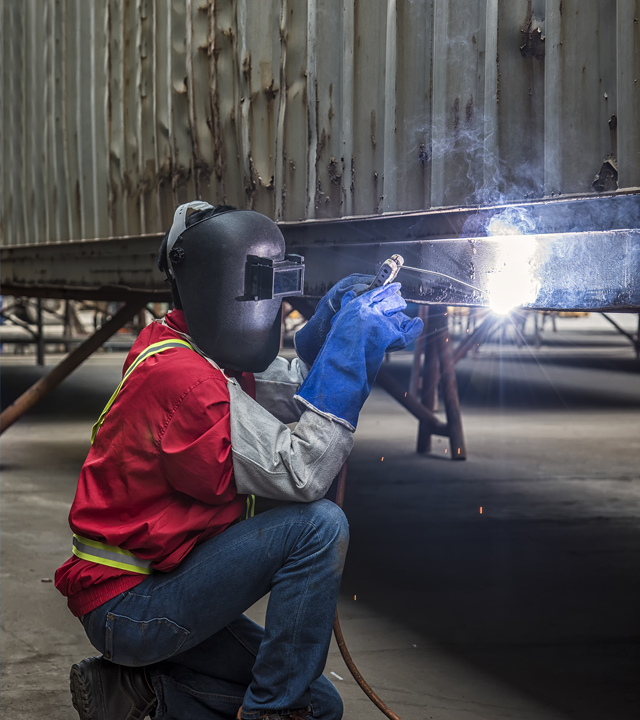Non-Destructive Testing (NDT) Inspection & Consulting
As a CWB certified company, we offer state of the art
welding inspection services all across Ontario and Quebec since 2007
Inspection Services
Inspection services are the backbone of our company. Our inspection services include:
- Visual inspection – W178.1
- Liquid Penetrant Inspection – CAN/CGSB-48.9712
- Magnetic Particle Inspection – CAN/CGSB-48.9712
- Eddy Current Inspection – CAN/CGSB-48.9712
- Ultrasonic Inspection – CAN/CGSB-48.9712
- Radiographic Inspection – CAN/CGSB-48.9712
- Coating Inspection - NACE CIP


Other related codes and standards offered but not limited to:
- CSA W47.1 – Welded Steel Construction
- CSA W47.2 – Welded Aluminum Construction
- ASME VIII – Boiler & Pressure Vessel
- ASME B31.3 – Process Piping
- CSA Z662 – Oil & Gas pipeline systems
- API 650 – Welded Tanks for Oil Storage
Our services extend to auditing, consulting and NDT training. Training welders to pass their CWB exams is also possible.
How can we help you?
We serve clients throughout various industries as listed below

Petrochemical

Aerospace

Bridges

Railway Transportation

Road Vehicles

Machinery

Building Structures

Industrial Structures

Ships & Marine Structures

Offshore Structures

Pipelines

Storage Tanks

An approach to testing involves evaluating a structure without damaging the welding and its surroundings. It may involve different techniques of inspection and testing for a given Welding Procedure Qualification. Welding procedures are usually submitted to the CWB by every welding company that wishes to do CWB certified welding.
Welding Procedures are the guidelines of performing a weld and are usually categorized into two:
- Procedure Qualification Record (PQR)
- Welding Procedure Specification (WPS)
Procedure Qualification Records are the documented results of all inspections and tests obtained from the actual test samples.
Welding Procedure Specifications are the documented work instructions used by the welder for the conduction of the weld.
Non Destructive Testing (NDT) is the most widely used method for the analysis and evaluation of the welding. The weld is tested by analyzing the cracks, pores, discontinuities in the structure and surface roughness to ensure the quality and strength of the weld. All of this is done without damaging the structure and its components.
At APAP Inspection Inc., we offer NDT services and solutions.
Non-Destructive Testing (NDT) Methods:
1. Visual Inspection – VT:
It is the most popular, simplest, cheapest, and most widely used NDT technique. It is done using the naked eye and by the use of 10x magnifying glass to detect surface flaws such as cracks, porosity, and unfilled craters leading to repairs or rejection of the work.
Procedures adopted by Inspector:
It is divided into three categories:
1. Details to check Before welding:
- Materials and related standards (ASME, ASTM)
- Welder Documents
- Equipment and Electrodes
- Welding edge
- Root Openings
- Clearance of backing strip
- Fit up and Alignment
- Welding Procedures
2. Details to check During welding:
- Inter passing Temperature and Preheat
- Cleaning, chopping, grinding
- Discontinuities
- Post heating
3. Details to check After welding:
- Dimensional accuracy of Weldment
- Conformity to drawings
- Acceptability of welds concerning appearance and fabrication quality
- Presence of cracks, unfilled craters, undercuts, etc.
- Post heating Temperature
2. Liquid Penetrant Testing – LT:
This method is used to check nonporous materials for defects open to the surface.
Liquids used:
- Aerosols cans of cleaner
- Dye
- Developer
Procedure:
It is divided into five steps:
- The surface with crack, grease, and dirt is found.
- The surface is cleaned with cleaner from inside out.
- The surface is coated with a penetrating liquid which seeps in the crack by the capillary action.
- The excess coating material is removed from the surface.
- A Developer is applied; it draws the penetrant from the discontinuity to the surface, so the flaw is seen.
The procedure conforms to ASTM E 165.
3. Magnetic Particle Testing – MT:
It is the process in which the part to be inspected is magnetized by passing through a low-voltage or passing a magnetic field. Electrical poles at the end of the crack are charged. Fine magnetic particles are applied to the surface, their concentration on the respective pole will indicate flaw.
The procedure conforms to ASTM E 138, ASTM E 709, MIL-I-6868.
4. Radiographic Testing – RT:
In this testing procedure, a radioisotope, e.g., Cobalt-60, is put in an X-ray tube, emits radiations, which are thrown on the film under the surface to be inspected. The beams pass through the cracks of the surface on the film. The film, when developed, locates the internal flaws of the surface.
The procedure conforms to ASTM E 94, ASTM E 142, and AWS D1.1.
5. Ultrasonic Testing – UT:
This technique locates both internal and surface flaws. It uses an ultrasonic transducer of 0.1 – 15.0 MHz range frequency and angle of the beam of 60 degrees.
The ultrasonic transducer sends a beam that enters the specimen and is reflected the transducer; when an interface is encountered, it locates a flaw.
The procedure conforms to ASTM E 164 and AWS D1.1.
6. Eddy Current Testing – ET:
It uses Electromagnetic induction to detect flaws in conductive materials. A circular coil is placed near the specimen, and an eddy current is produced, which produces a magnetic field. Variations in magnetic field Detect flaws.
The procedure conforms to ASTM E 94, ASTM E 142, and AWS D1.1.
7. Coating Inspection – CIP:
This method involves the testing of liquid and dry coatings on ferrous and non-ferrous substrates.
Procedure:
The procedure for coating inspection can vary depending on the industry but the most common factors when inspecting are the following;
- The surface profile
- The wet and dry film thickness of the coating
- Appearance and color
- Adherence
- Visual conformities
Get Your Free Consultation
Let us take care of all your inspection needs. We employ some of the industry’s finest NDT inspectors.
Throughout the years of my career, the best inspectors I met were amazing welders” -Amarpal
Our Company
Business
Contact Details
© 2021 APAP Inspection Inc. All Rights Reserved. Permit Number: AP-2001331


